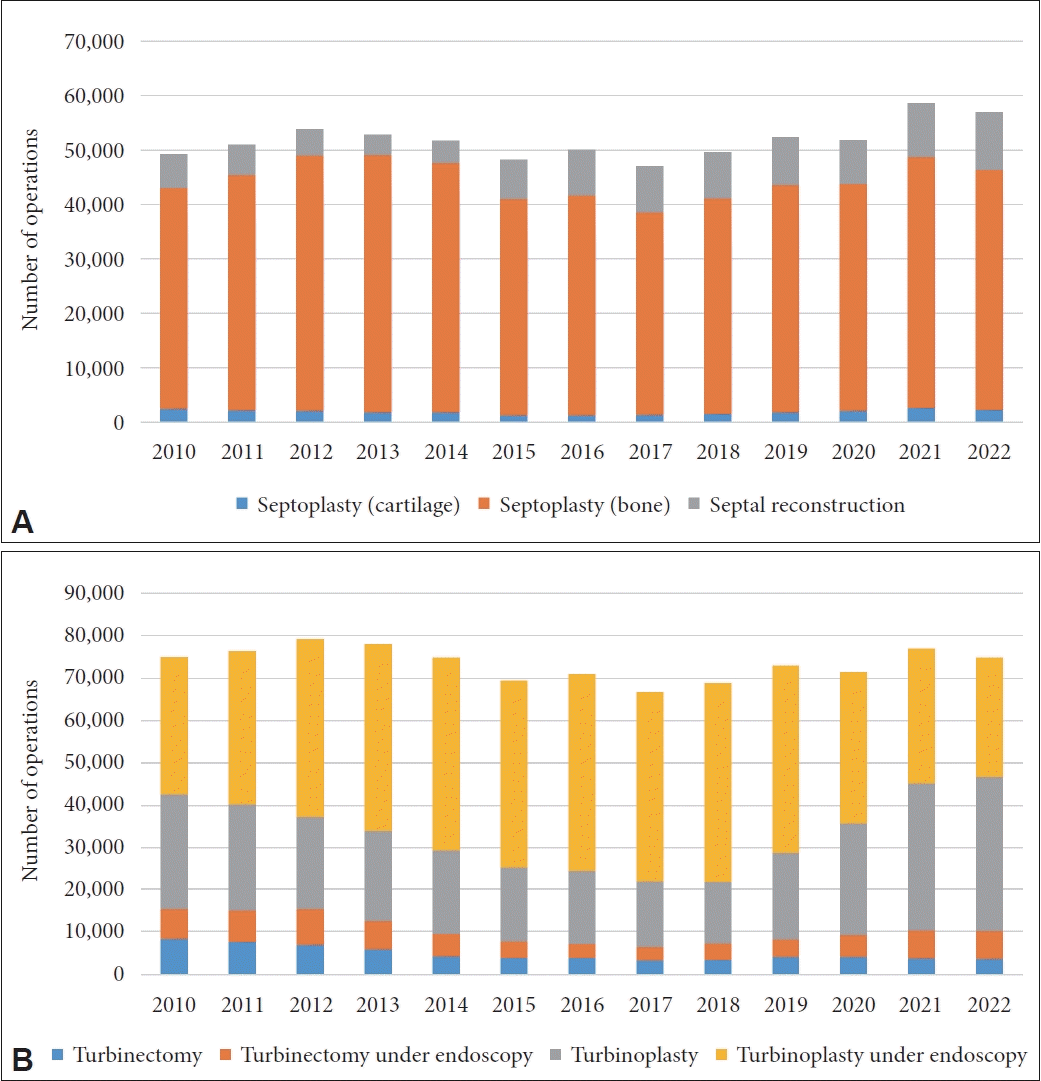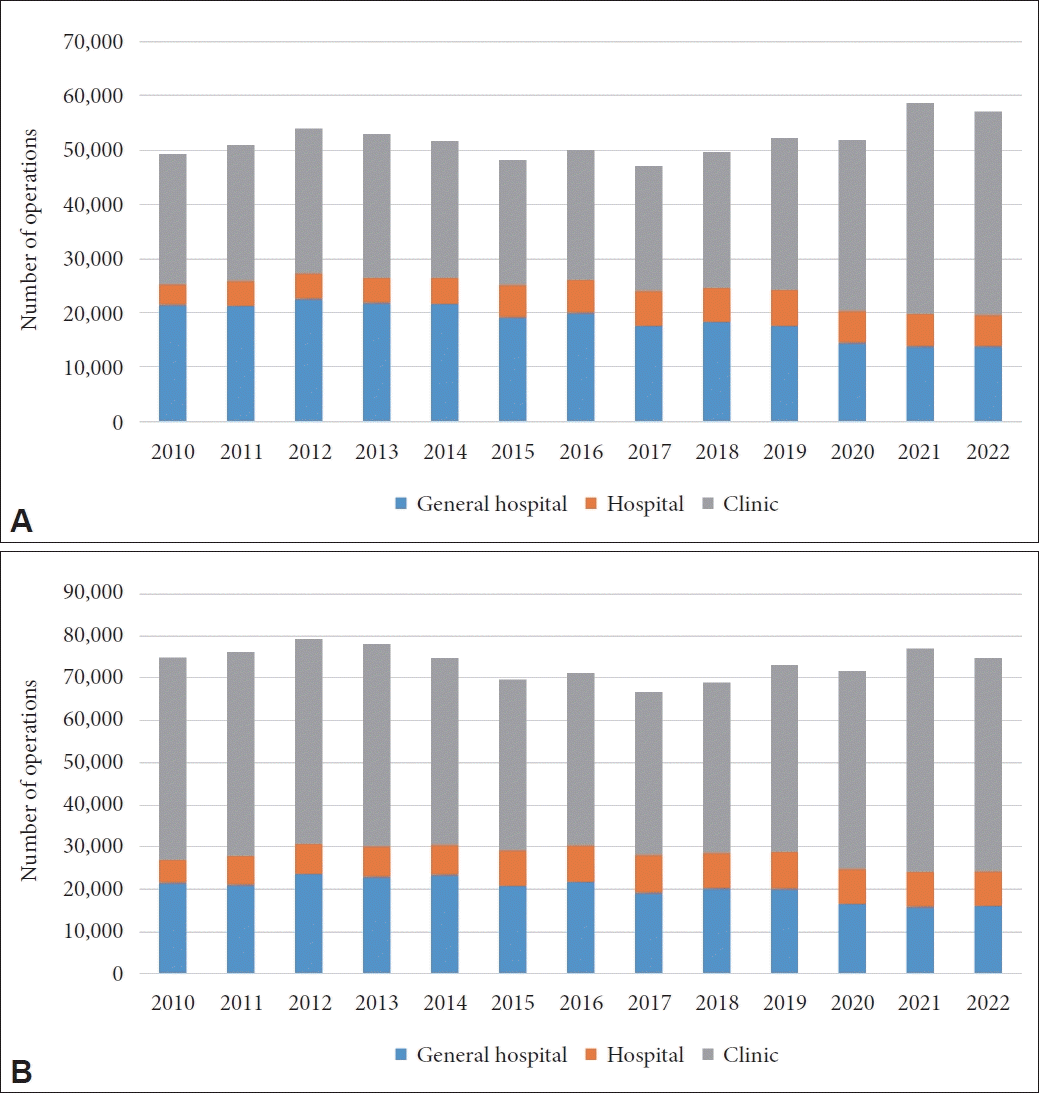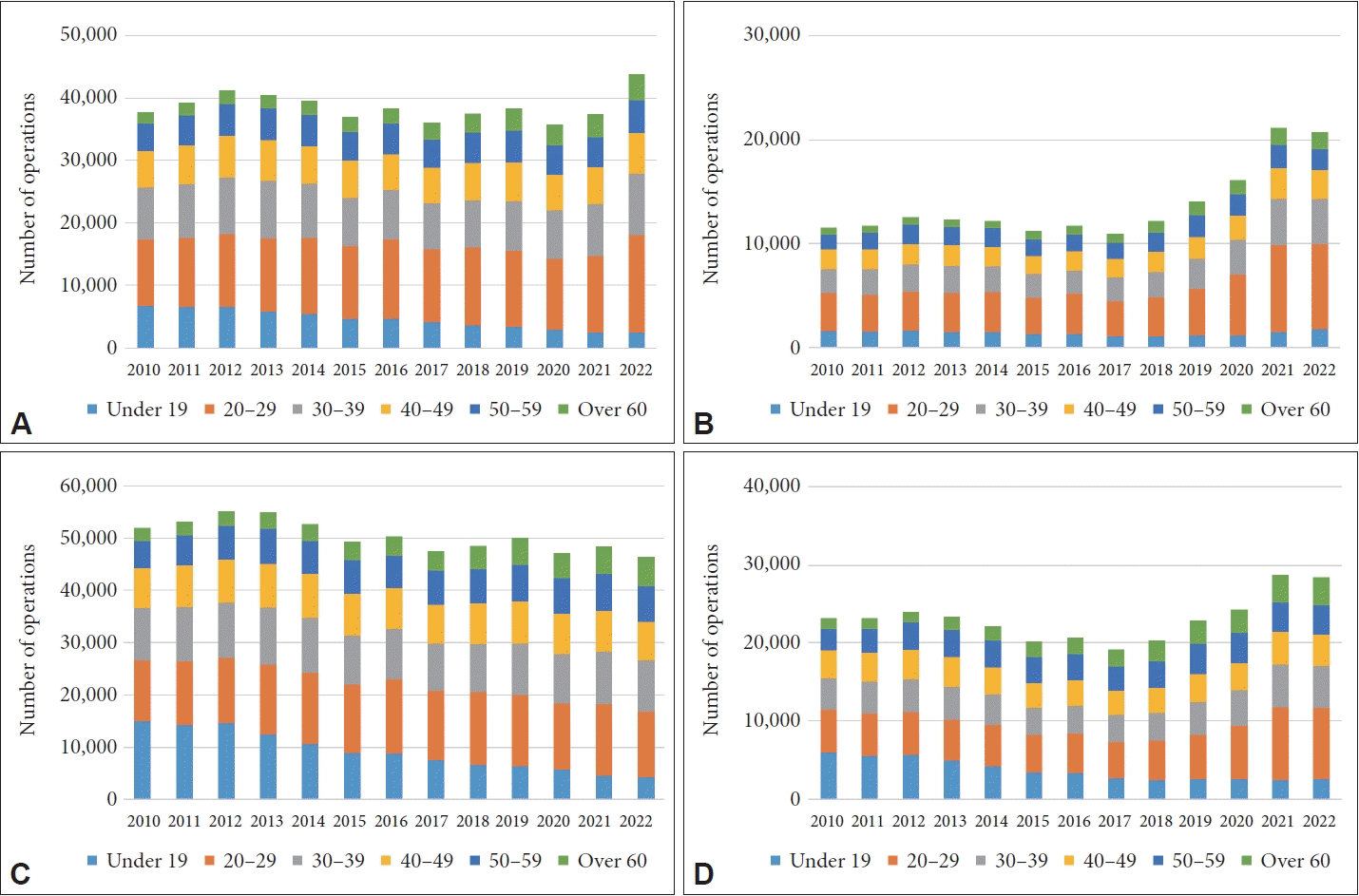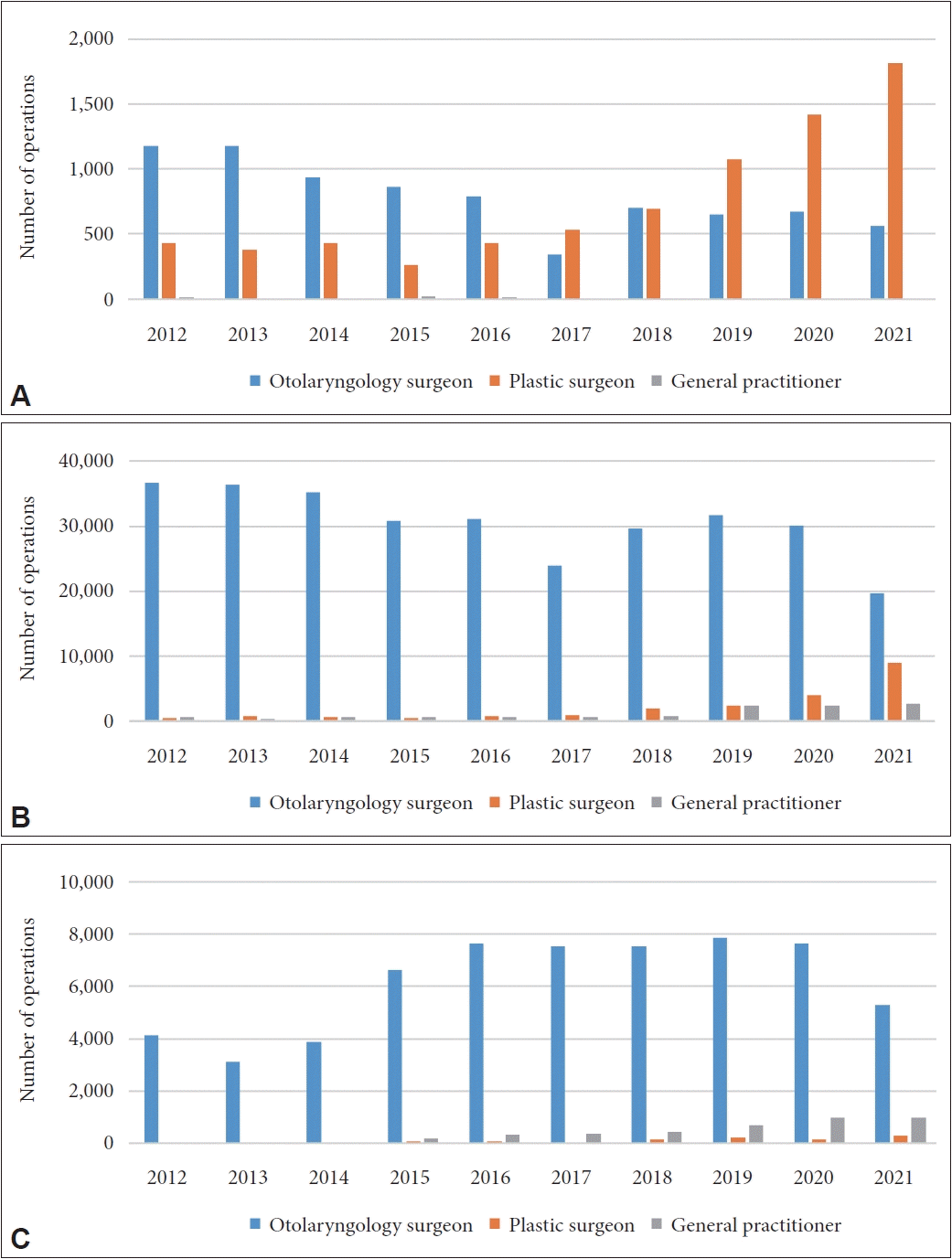Abstract
Background and Objectives
Since the introduction of nasal valve surgery, trends in septoplasty and inferior turbinate surgery (ITS) have changed in Korea. However, a detailed analysis of these changes has yet to be conducted.
Methods
Data on septoplasty and ITS performed from 2010 to 2022 were extracted from the Health Insurance Review and Assessment Service (HIRA) Bigdata Open portal and trends were analyzed. Analyses according to the type of medical institution, patient sex and age, and the specialty of the surgeon were also conducted.
Results
The frequency of both septoplasty and ITS gradually decreased from 2012 to 2017, which marked the low point, and the frequency of these procedures gradually increased thereafter. In 2010, 41.5% of septoplasty procedures were performed in general hospitals, 7.3% in hospitals, and 47.3% in clinics. However, the proportion of these procedures performed in general hospitals subsequently decreased, while the corresponding proportion in hospitals and clinics increased. Both septoplasty and ITS were performed more than twice as often in men than in women. The number of patients under the age of 19 decreased, while the number of female patients aged 20–29 increased. The number of septoplasty procedures performed by plastic surgeons increased.
Nasal septal deviation and hypertrophic rhinitis frequently cause nasal obstruction. When adequate medical treatment fails to improve these conditions, surgical interventions are considered [1-4]. Septoplasty is the procedure of choice for nasal septal deviation. For hypertrophic rhinitis, a variety of surgical techniques, including turbinoplasty and submucosal inferior turbinectomy, are utilized. Additionally, tools such as microdebriders, lasers, and radiofrequency devices are employed in inferior turbinate surgery (ITS) [1-4].
Historically, septoplasty and ITS were primarily performed by otorhinolaryngologists. However, the landscape began to shift in 2016 when nasal valve reconstruction surgery was classified as a non-covered surgery [5]. This change has led to an increase in the practice of integrating valve surgery as an adjunct procedure in plastic surgery. As a result, valve surgery is now more frequently performed by plastic surgeons than by otorhinolaryngologists [6]. As most patients requiring nasal valve reconstruction surgery also present with nasal septal deviation and hypertrophic rhinitis, these procedures are frequently performed concurrently. This has resulted in a significant increase in the number of septoplasty and ITS procedures being carried out in plastic surgery practices. However, there has been no prior reporting of statistical data on the trends of septoplasty and ITS, which is crucial for the development of future strategies.
In this study, we analyzed data from the Health Insurance Review and Assessment Service (HIRA) Bigdata Open portal (https://opendata.hira.or.kr/home.do) to examine trends in the performance of septoplasty and ITS from 2010 to 2022. We assessed the number of procedures performed, the sex and age distribution of patients, the types of medical institutions performing the procedures, and changes in the specialization of healthcare providers.
We extracted the data from healthcare statistics provided by the HIRA Bigdata Open portal (https://opendata.hira.or.kr/home.do). Within the healthcare statistics, we searched for procedure-specific statistics about septoplasty and ITS (Table 1) under the disease/procedure-specific healthcare statistics category. At the time of the search on July 8, 2023, the maximum search period provided by the HIRA Bigdata Open portal was from 2010 to 2022. However, endoscopic septoplasty (O1005, O1006, O1007) was added to the reimbursement list in August 2021 (Ministry of Health and Welfare Notification No. 2021-227), so the corresponding data were only available for 2021 and 2022. The analysis included endoscopic septoplasty within the category of septoplasty, and a sub-analysis was conducted distinguishing between procedures performed endoscopically and those performed non-endoscopically. ITS was mostly performed on both sides, making it challenging to compare with septoplasty; hence the number of procedures was aggregated based on the number of patients. Additionally, analyses were conducted according to the type of healthcare facility, patient sex, and age group. Regarding the healthcare facility classification, tertiary general hospitals and general hospitals were merged into one category (hereafter referred to as “general hospitals”), while other hospitals and clinics were analyzed separately. Age groups were categorized as under 19, 20–29, 30–39, 40–49, 50–59, and 60 or older. Furthermore, we obtained data about specialized departments that performed septoplasty (O1001, O1002, O1003) from 2010 to 2021, excluding the three types of endoscopic septoplasty defined by the Korean Medical Association and conducted an analysis. Since this study used publicly available statistical data and did not utilize individual patient information, it did not require Institutional Review Board (IRB) approval.
Septal and turbinate surgical procedures included in the study
The number of septoplasty and ITS procedures gradually decreased from 2012 to 2017, followed by a gradual increasing trend until 2021. Annually, approximately 20,000 more ITS procedures have been performed compared to septoplasty (Fig. 1 and Supplementary Table 1 in the online-only Data Supplement). Within the category of septoplasty, the “touching bone” variant accounted for the majority at 82.3%, followed by septal reconstruction at 14.1%. The “touching cartilage” variant of septoplasty comprised only 3.6%. This analysis also incorporated endoscopic septoplasty data from 2021 onwards, and there has been a noticeable increase in the number of these procedures (Supplementary Table 2 in the online-only Data Supplement). In the case of ITS, turbinoplasty (including endoscopic procedures) made up 86.0%, exceeding the percentage of turbinectomy (including endoscopic procedures) at 14.0% (Fig. 1 and Supplementary Table 3 in the online-only Data Supplement). From 2010 to 2018, the number of endoscopic turbinoplasty procedures steadily increased, while the number of turbinoplasty procedures decreased. However, from that point until 2022, the number of endoscopic turbinoplasty procedures has declined, while the number of turbinoplasty procedures has significantly increased.
In 2010, septoplasty procedures were performed in various settings: 41.5% in general hospitals, 7.3% in hospitals, and 47.3% in clinics. Over the subsequent years, the proportion of these procedures conducted in general hospitals steadily declined, while the percentages in hospitals and clinics increased. By 2022, 23.3% of septoplasties were performed in general hospitals, 9.9% in hospitals, and 63.4% in clinics (Fig. 2 and Supplementary Table 4 in the online-only Data Supplement). Regarding ITS procedures, in 2010, 28.4% were performed in general hospitals, 7.3% in hospitals, and 64.2% in clinics. These proportions remained relatively stable through 2022 (Fig. 2 and Supplementary Table 5 in the online-only Data Supplement).
Septoplasty and ITS procedures were performed more frequently on males, with males undergoing approximately 2.8 times more septoplasty and 2.2 times more ITS procedures. There was a sharp decrease in the number of male patients under 19 receiving septoplasty or ITS, with septoplasty cases dropping by 63.2% from 6,804 in 2010 to 2,500 in 2022, and ITS cases decreasing by 72.0% during the same period, from 14,968 to 4,192 (Fig. 3, Supplementary Tables 6 and 7 in the online-only Data Supplement). Conversely, there was a significant increase in these procedures for females aged 20–29 starting from 2018, with septoplasty cases rising by 218.6% from 3,721 in 2018 to 8,134 in 2022, and ITS cases increasing by 182.5% during the same period, from 4,968 to 9,065. Furthermore, the number of septoplasty and ITS operations for both male and female patients aged 60 and above continued to rise.
Septoplasty (touching cartilage), which was the least frequently performed septoplasty procedure, showed a significant increase in the number of procedures performed by plastic surgeons over otorhinolaryngologists since 2017. In 2021, plastic surgeons performed septoplasty (touching cartilage) 3.2 times more frequently than otorhinolaryngologists, with 1,815 procedures and 562 procedures, respectively (Fig. 4 and Supplementary Table 8 in the online-only Data Supplement). Septoplasty (touching bone), which accounted for over 80% of septoplasty procedures, was primarily performed by otorhinolaryngologists before 2018. However, from 2018, the number of procedures performed by plastic surgeons and general practitioners gradually increased. In 2021, among a total of 31,359 septoplasty (touching bone) procedures, otorhinolaryngologists performed 19,608 (62.5%), plastic surgeons performed 8,909 (28.4%), and general practitioners performed 2,635 (8.4%). For septal reconstruction, otorhinolaryngologists continued to perform the majority of procedures, but the proportion performed by doctors with other specialties has been gradually increasing.
From 2012 to 2017, there was a gradual decline in both septoplasty and ITS procedures. However, these began to rise again in 2018, two years after nasal valve reconstruction was reclassified as a non-covered surgery. This uptick is likely attributable to an increase in nasal valve reconstructions, which are performed in conjunction with septoplasty and ITS.
When analyzing trends by types of medical institutions, it becomes clear that ITS procedures have been performed more than twice as often in clinics than in general hospitals (48,239 cases vs. 21,365 cases) since 2010. ITS is viewed as a relatively simple procedure, which may explain why many clinics opt to perform this surgery. From 2021, general hospitals have experienced a decline in the number of ITS cases to 15,812, while the number of cases in clinics has remained relatively stable. In 2010, septoplasty cases were evenly distributed between general hospitals (21,296 cases) and clinics (24,249 cases). However, general hospitals have since seen a reduction of over 30%, while clinics have experienced an increase of over 50%. This trend could be attributed to the growing number of otorhinolaryngology clinics performing various surgical procedures, including nasal valve reconstruction, and plastic surgery clinics also offering nasal valve reconstruction [6].
Males outnumbered females by more than two-fold among patients undergoing septoplasty and ITS. There have been reports of a higher prevalence of nasal septal deviation in Korean males (56.9%) compared to females (40.4%) and the prevalence of chronic rhinitis was higher in females (7.5% for females vs. 34.7% for males) [7,8]. Therefore, the difference in prevalence rates does not appear to be the primary reason for the sex disparity in surgery. The number of patients aged 19 and under undergoing both procedures has dramatically decreased, which may attributed to the rapid decline in birth rates in Korea. An intriguing observation is the nearly twofold increase in septoplasty and ITS procedures among females aged 20–29 from 2018 to 2022. This trend is likely due to the fact that young women, who are the main recipients of cosmetic rhinoplasty, often undergo concurrent procedures such as nasal valve reconstruction, septoplasty, and ITS [9].
The majority of medical specialists performing septoplasty are otorhinolaryngologists. However, since 2018, there has been a notable rise in the number of plastic surgeons and general practitioners conducting this type of surgery.
This study has several limitations. First, the study relied on claims data, which may not always accurately reflect the exact surgical procedure. Second, it was not possible to determine the number of cases in which both septoplasty and ITS were performed simultaneously. Third, while it appears that nasal valve reconstruction may have had an impact on the increase in septoplasty and ITS, data on nasal valve reconstruction surgery were not available. Last, the analysis of specialists’ departments only encompassed septoplasty.
In summary, there has been a steady increase in the number of septoplasty and ITS procedures since 2018. These procedures are increasingly being performed in clinics rather than general hospitals. Overall, more male patients underwent these operations than female patients, but a significant increase has been observed among young female patients since 2018. Although otorhinolaryngologists have traditionally been the primary practitioners performing these surgical procedures, an increasing number of other medical specialists are becoming involved.
Supplementary Materials
The online-only Data Supplement is available with this article at https://doi.org/10.18787/jr.2023.00065.
Supplementary Table 2.
Septal surgery and endoscopic septal surgery in 2021 and 2022
Supplementary Table 4.
Septal surgery by type of medical institution
Supplementary Table 5.
Turbinate surgery by type of medical institution
Notes
Availability of Data and Material
The datasets generated or analyzed during the study are available from the corresponding author on reasonable request.
Conflicts of Interest
Jae Hoon Cho who is on the editorial board of the Journal of Rhinology was not involved in the editorial evaluation or decision to publish this article. All remaining authors have declared no conflicts of interest.
References
1. Jin HR, Won TB. Septoplasty; current concept and technique. J Rhinol. 2008; 15(1):13–29.
2. Ahn BH. A practical and clinical application of the septoplasty. Korean J Otorhinolaryngol-Head Neck Surg. 2015; 58(2):79–87.

3. Choi SC, Lim DJ, Kang SH, Kim BH, Kim HS, Ahn JY. Inferior turbinate surgery for chronic hypertrophic rhinitis: comparison of three techniques. Korean J Otorhinolaryngol-Head Neck Surg. 2008; 51(7):630–5.
4. Lee JS, Min HK, Kim NK, Oh HM, Son WS, Park BC. The long term efficacy of microdebrider assisted versus coblation assisted inferior turbinoplasty. Korean J Otorhinolaryngol-Head Neck Surg. 2011; 54(8):532–8.

5. Hwang SH, Kim SW. The recommendation of the methods to evaluate the nasal valve problem in the consideration of nasal valve reconstruction. Korean J Otorhinolaryngol-Head Neck Surg. 2022; 65(9):483–90.

6. Park YJ. [Chronic rhinitis turns into rhinoplasty...Disability insurance leaks like this] [Internet]. Seoul: Kbanker;2022. [cited 2023 Jul 1]. Available from: https://www.kbanker.co.kr/news/articleView.html?idxno=203084. Korean.
7. Han C, Park SM, Lim JS, Kwon JW. Association of dietary factors with presence and severity of septal deviation: results of the Korean national health and nutrition survey 2010–2012. Korean J Otorhinolaryngol-Head Neck Surg. 2018; 61(1):24–8.

8. Im D, Yang YS, Choi HR, Choi S, Nahm H, Han K, et al. Prevalence of allergic disease in Korean adults: results from the Korea national health and nutrition examination survey (2010–2012). Korean J Otorhinolaryngol-Head Neck Surg. 2017; 60(10):504–11.

9. Lee YK. [Plastic surgery is also a generation gap...Preferences vary by age] [Internet]. Seoul: Medical News;2006. [cited 2023 Jul 1]. Available from: http://www.bosa.co.kr/news/articleView.html?idxno=78814. Korean.




 PDF
PDF Citation
Citation Print
Print







 XML Download
XML Download